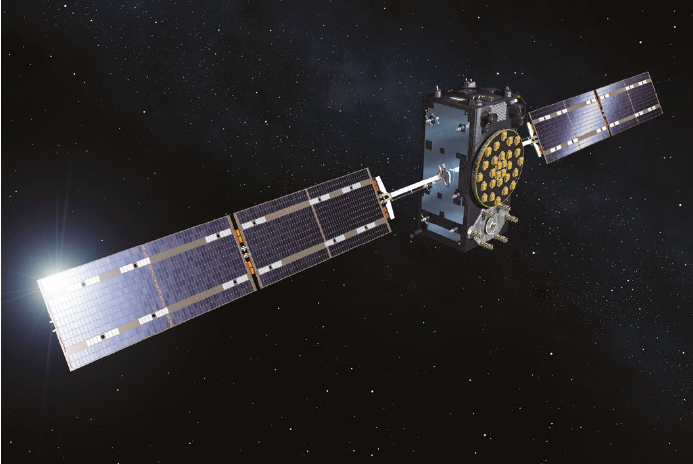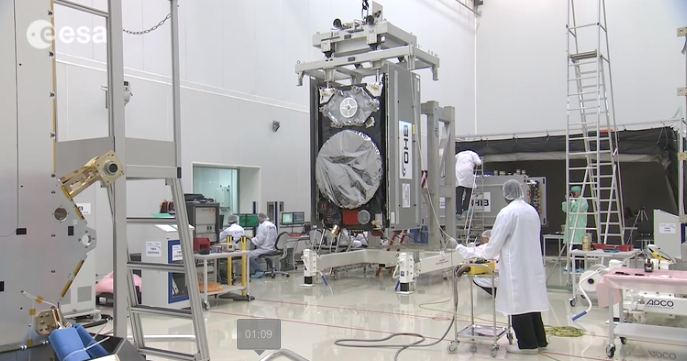
Galileo FOC-M4, Sat 11-12 Satellites
[Satnews] For its 12th flight of the year, and the 13th Soyuz launch overall from the Guiana Space Center (CSG), Arianespace will orbit another pair of satellites for the Galileo constellation. This mission, conducted for the European Commission under a contract with the European Space Agency (ESA), will orbit Galileo FOC (Full Operational Capability) satellites 11 and 12.
After this flight, 12 Galileo satellites will have been deployed by Arianespace, which is proud to be serving Europe as launch service provider for this its independent access to space.
Galileo, an iconic project for Europe...
Galileo is a European initiative to develop a new global satellite navigation system. Under civilian control, it will offer a guaranteed, high-precision positioning service and will end Europe’s dependence on the American GPS system. Galileo is the first joint infrastructure produced and funded by the European Union. It features innovative technologies developed in Europe for the benefit of all citizens.
Stepping up deployment in 2015...
- Arianespace orbited the Galileo IOV 1 and 2 (In-Orbit Validation) satellites on the first Soyuz flight (VS01) on October 21, 2011, followed by IOV 3 and 4 on VS03 on October 12, 2012, all from the CSG.
- Prior to that, the GIOVE-A and GIOVE-B experimental satellites were launched from the Baikonur Cosmodrome by Soyuz (via Starsem) in 2005 and 2008.
- The first two Galileo FOC satellites (5 and 6) were launched on August 22, 2014. Despite injection into a non-compliant orbit, the ESA teams were able to validate their operation, then reposition them so that they can contribute to the constellation.
- On March 26 and September 10, 2015, Soyuz flights VS11 and VS12 successfully launched Galileo FOC satellites 7, 8, 9 and 10.
- After this latest launch, Arianespace will pursue deployment of two more FOC satellites using a Soyuz rocket, followed by 12 using three Ariane 5 rockets from the CSG.
- The next mission for the Galileo program is planned for the second half of 2016, using the first Ariane 5 ES, which will carry four satellites.

On 17 December, Galileo satellites 11 and 12 will be launched on top of the legendary Soyuz rocket from Europe's Spaceport in French Guiana. Ten years after the launch of GIOVE A, on December 28, 2005, Galileo is now a reality.
Made in Europe...
The Galileo satellites are built by prime contractor OHB System in Bremen, Germany. The payload for each satellite is supplied by UK-based Surrey Satellite Technology Ltd (SSTL), which is 99 percent owned by Airbus Defence and Space.
These will be the seventh and eighth OHB satellites launched by Arianespace. The next 14 are under construction at OHB in Bremen.
Mission Description
The 13th Soyuz launch from the Guiana Space Center (CSG) will place two new satellites for Europe’s Galileo satellite navigation system into circular orbit. The launcher will be carrying a total payload of 1,603 kg. The launch will be from the Soyuz Launch Complex (ELS) in Sinnamary, French Guiana.
Targeted orbit: MEO circular orbit - Orbital Plane C
Altitude: 23,222 km
Inclined: 54.946 degrees
Liftoff is scheduled for Thursday, December 17, 2015 at exactly:
- 08:51:56 a.m., (Local time in French Guiana)
- 06:51:56 a.m., (in Washington, D.C.)
- 11:51:56 a.m., (UTC)
- 12:51:56 p.m, (in Paris)
- 4:51:56 p.m., (in Moscow)
The launch at a glance...
Following liftoff from the Guiana Space Center, the powered phase of the lower three Soyuz stages will last about nine minutes. The third stage of the launcher will then be separated from the upper composite, comprising the Fregat upper stage and the Galileo FOC-M4, SAT 11-12 satellites. The three lower stages and the fairing will fall back into the sea.
After a first burn, the upper composite is spun up during a ballistic phase lasting about 3 hours and 15 minutes. Then, Fregat will ignite its own engine to bring the upper composite to a transfer orbit above the Earth.
At a pre-determined point of this orbit, Fregat will ignite for a second burn lasting 4 minutes to reach the circular orbit of separation. At the end of the mission, the Fregat upper stage will be passivated.
The Galileo FOC-M4 SAT 11-12 satellites will then lower their altitude in order to reach their operational orbit.
Soyuz payload configuration
- Payload: Galileo FOC-M4, SAT 11-12
- Mass at liftoff: 717 and 717.5 kg.
- ST Fairing
- Dispenser (carrying structure) for the two Galileo FOC-M4 payloads, developed and built by RUAG Space

